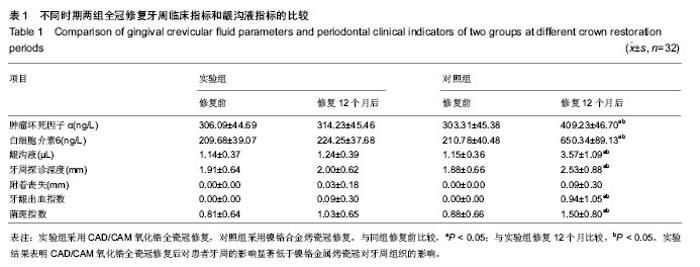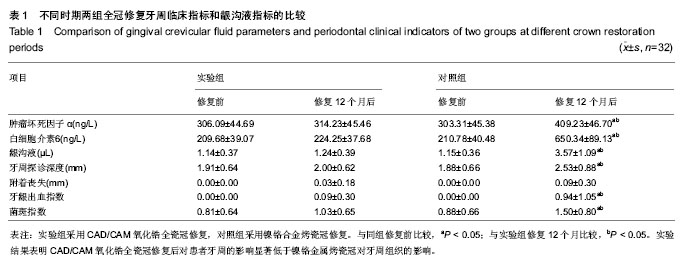| [1] 丁玉宝,杨建军,杨凤丽,等.氧化锆陶瓷材料的生物相容性[J].中国组织工程研究与临床康复,2011,15(12):2153-2156.
[2] 李立刚,常晓峰.氧化锆材料的生物相容性研究[J].陕西医学杂志, 2013,42(6):657-658.
[3] 黄慧,李静,张富强.5种着色氧化锆陶瓷的细胞毒性评价[J].临床口腔医学杂志,2007,23(7):405-407.
[4] 李伟,蒋丽,廖运茂.牙科氧化锆全瓷材料[J].中国实用口腔科杂志,2010,3(8):455-457.
[5] Ardlin BI.Transfomation- toughened zirconia for dentalinlays,crowns and bridges: chemical stability and effect oflow- temperature aging on flexural strengh and surface.Dent Mater. 2002;18(8):590-595.
[6] 李洪洋,钟丽芳.氧化锆全瓷冠对患牙牙周组织的影响[J].中国医科大学学报,2010,39(12):1028-1032.
[7] 曹福春,张昀,张卫平.计算机辅助设计与计算机辅助制作在口腔临床的应用观察[J].甘肃科技,2013,29(11):144-145.
[8] 牛艳萍.计算机辅助设计/计算机辅助制作氧化锆烤瓷冠在口腔修复中的临床运用[J].山西医药杂志,2013,42(4):420-421.
[9] 孙凤,张桂荣.CAD/CAM氧化锆全瓷在口腔修复领域的应用[J].上海口腔医学,2006,15(4):337-344.
[10] 吴文桢,张昀,张卫平,等.CAD/CAM二氧化锆全瓷冠在口腔修复中的应用[J].卫生职业教育,2014,32(1):151-152.
[11] 林海书,谢莉莉.氧化锆全瓷冠修复后牙48例临床观察[J].海南医学,2014,25(1):110-111.
[12] 许咏梅,李静,张继荣.氧化锆全瓷冠在临床修复中的应用[J].中国社区医师医学专业,2012,14(8):171.
[13] 关达荣,张佩芬.氧化锆全瓷冠桥修复体临床效果评价[J].中国实用口腔科杂志,2011,4(2):87-90.
[14] 孙晓军,孟焕新,陈智滨,等.侵袭性牙周炎患者血浆白细胞介素-1 β和肿瘤坏死因子-a的检测[J].北京大学学报:医学版, 2008, 40(1): 24-27.
[15] Devlin RD,Reddy SV,Savino R,et al.IL-6 mediates the effects of IL-1 or TNF, but not PTHrP or 1,25(OH)2D3, on osteoclast-like cell formation in normal human bone marrow cultures.Bone Miner Res.1998;13:393-399.
[16] Graves DT,Cochran D.The contribution of interleukin.1 and tumor necrosis factor to periodontal tissue destruction.J Periodontal.2003;74(3):391-401.
[17] 吴亚菲,赵川江,张静仪,等.牙龈沟液中白细胞介素-6 含量与牙周炎关系的研究[J].华西医科大学学报,2000,31(4):494-496.
[18] 刘荣坤,曹采方,孟焕新,等.TNF-α及IL-1β与多型核白细胞在牙周炎症组织浸润的关系[J].中华口腔医学杂志, 2000,35(5): 327-329.
[19] 李岩涛,贺兰,李洁,等.牙周炎龈组织肿瘤坏死因子-α的含量及其与牙周炎的关系[J].口腔医学,2002,22(1):12-14.
[20] 吕卉.氧化锆全瓷修复后1年的牙周状况分析[J].中国实用口腔科杂志,2010,3(6):367-368.
[21] 袁堂霞,张彦表,吴正华.不同金属烤瓷全冠对龈沟液内可溶性细胞间黏附分子-1及白细胞介素-1β水平的影响[J].华西口腔医学杂志,2011,29(5):477-480.
[22] 袁堂霞,张彦表,吴正华,等.纯钛烤瓷全冠对基牙牙周组织健康的影响[J].口腔颌面修复学杂志,2011,12(2):80-83.
[23] 何艳萍,谢明,焦婷,等.2种滤纸用于采集龈沟液的性能比较[J].上海口腔医学,2012,21(1):79-83.
[24] 周坚,邹石莹,赵葳,等.龈沟液的量与牙周组织炎症的关系[J].中国医学科学院学报,1994,16(3):179-182.
[25] 许卫星,苏俭生.3种金属烤瓷冠修复后龈沟液中白细胞介素-8水平动态测定[J].华西口腔医学杂志,2012,30(3):255-258.
[26] 秦德川,卓峰.CAD/CAM氧化锆全瓷冠修复对患牙牙周组织影响的研究[J].泰山医学院学报,2011,32(8):586-588.
[27] 常春荣,韩东,孙尚敏,等.牙周基础治疗对慢性牙周炎患者龈沟液白细胞介素6、肿瘤坏死因子α及血清高敏C反应蛋白的影响[J].中国医科大学学报,2013,42(2):135-137.
[28] 薄祥春,李大典.牙周炎患者龈沟液IL-6、IL-8 和TNF-α检测的临床意义[J].放射免疫学杂志,2012,25(6):604-641.
[29] 王磊,彭式韫,刘青.白细胞介素与牙周炎的关系[J].牙体牙髓牙周病学杂志,2003,13(1):53-56.
[30] 孙培音,王亚锋,法永红,等.不同种类金属烤瓷底冠与基牙龈沟液的变化[J].中国组织工程研究与临床康复,2011,15(12): 2183-2186.
[31] Shillingburg HT Jr,Hobo S,Fisher DW.Preparation design and margin distortion in porcelain-fused-to-metal restorations.1973.J Prosthet Dent.2003;89(6):527-532.
[32] Schmalz G,Schuster U,Schweik H.Influence of metals on IL-6 release in vitro.Biomaterials.1998;19(18):1689-1694.
[33] 朱蔚蓉,严吴慧,柳素红.牙周炎患者龈沟液CRP、IL-6和TNF-α检测的临床价值[J].放射免疫学杂志,2012,25(1):101-102.
[34] 吴艳,伏艳,米方林.成人牙周炎患者正畸治疗前后TNF-α含量的变化[J].临床口腔医学杂志,2012,28(7):400-402.
[35] 江泳,陈智滨,冯海兰.镍铬合金烤瓷冠修复上领切牙对牙周组织的影响[J].口腔医学,2004,24(5):279-280.
[36] Glassman S.Digital impressions for the fabrication of aesthetic ceramic restorations:a case report.Pract Proced Aesthet Dent.2009;21(1):60-64.
[37] Farah JW,Brown L.Comparison of the Fit of Crowns Based on Digital Impressions with 3M ESPE Lava Chairside Oral Scanner C.O.S. vs. Traditional Impressions.Dent Adv Res Report.2009;(22):1-3.
[38] 邓旭亮,胡晓阳,欧阳翔英,等.牙冠轴面突度变化对牙周组织健康的影响[J].中华口腔医学杂志,2001,36(6):440-442.
[39] 曹福春,张昀,张卫平.计算机辅助设计与计算机辅助制作在口腔临床的应用观察[J].甘肃科技,2013,29(11):144-145.
[40] 牛艳萍.计算机辅助设计/计算机辅助制作氧化锆烤瓷冠在口腔修复中的临床运用[J].山西医药杂志,2013,42(4):420-421.
[41] 杨荣红.三种材料烤瓷冠修复后对牙周组织的影响[J].海南医学, 2011,26(16):61-62.
[42] Cionca N,M€uller N,Mombelli A. Two-piecezirconiaimplant ssupporting all-ceramiccrowns: A prospective clinical study.Clin Oral Implants Res.2014.In press.
[43] van Brakel R,Cune MS,van Winkelhoff AJ,et al.Early bacterial colonization and soft tissue health around zirconia and titanium abutments: an in vivo study in man. Clin Oral Implants Res.2011;22:571-577.
[44] Choi AH,Matinlinna J,Ben-Nissan B.Effects of micromovement on the changes in stress distribution of partially stabilized zirconia (PS-ZrO2) dental implants and bridge during clenching: a three-dimensional finite element analysis.Acta Odontol Scand.2013;71(1):72-81.
[45] Sagirkaya E,Arikan S,Sadik B,et al.A randomized, prospective, open-ended clinical trial of zirconia fixed partial dentures on teeth and implants: interim results.Int J Prosthodont.2012;25(3):221-231.
[46] 林海书,谢莉莉.氧化锆全瓷冠修复后牙48例临床观察[J].海南医学,2014,25(1):110-111. |

